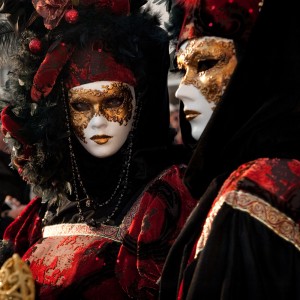The masks of the Venice Carnival
The masks of the Venice Carnival
The masks of the Venice Carnival
-
Hannah
-
Hannah
 What is more romantic, more mysterious, more alluring, more dangerous than a masquerade?
What is more romantic, more mysterious, more alluring, more dangerous than a masquerade?
Last week I wrote about the Commedia dell’arte, a 16th-century Italian dramatic form that originated in Venice in which masked actors improvise in stock roles to entertain the audience. The masks are a vital and universally recognisable feature of the Commedia, and so too are they inherent in the tradition of the Venice Carnival – an event that features in the opening of my new romance novel, The Echoes of Love.
Venetian masks date back to the parties Venetians held during the 13th century at which they would wear beautiful masks to conceal their identities, so allowing both upper and lower classes to mingle freely and live out their fantasies (plenty of debauchery would follow, from gambling to affairs).
In today’s Carnival, party-goers and revellers in the street parades wear traditional Venetia masks of two kinds – those of the Commedia dell’arte, and specific Carnival ones. Well-known Carnival masks include:
- The Bauta, which is always white and covers the whole face, and is often worn with a tricorno hat.
- The black velvet Moretta, worn by women and traditionally held in place by gripping a protrusion with the teeth, thus rendering the woman silent!
- The Columbina, an eye mask that became very popular (after all, revellers want to be able to eat and drink easily!)
This website has some great pictures of these masks, and this site gives a fabulous overview of the main mask types worn.
The tradition of the Carnival mask dates back hundreds of years. Notable features include:
- Vibrant colours
- Extravagance, as visible in the fine adornments
- Individuality – each mask is unique
- Artistry – these are very much works of art
- Wide ranging materials: gold leaf, fur, lace, sequins, precious fabrics, feathers, gems, beads, metallic objects, papers… the list is endless
Some masks are made from porcelain – these are the most expensive masks, and are often used as wall décor now rather than for wearing. Others are made from leather – a true artisan’s mask; when my heroine Venetia first sees Paolo in The Echoes of Love during a Carnival party she is drawn to his eyes ‘behind the devilish features of his half-face leather black mask’. But more typically, masks are made from a kind of papier mâché, allowing the mask artists complete control in crafting the contours. The papier mâché is applied to a mold made from plaster or clay and lubricated with Vaseline, and then baked in an oven until dry. Then eye holes are cut, and the artist sands, varnishes, paints and decorates the mask.
For some wonderful examples of masks – and if you feel like indulging yourself in an authentic Venetian mask for your next masquerade event – take a look at these website: Mask Italia, Venetian Mask Shop, 1001 Venetian Masks and Dream of Italy.